| کد مقاله | کد نشریه | سال انتشار | مقاله انگلیسی | نسخه تمام متن |
|---|---|---|---|---|
| 4142730 | 1272385 | 2009 | 7 صفحه PDF | دانلود رایگان |

ResumenObjetivodeterminar en una unidad neonatal de nivel II la frecuencia de nacimientos tras fecundación in vitro (FIV) incluyendo FIV-ICSI (intracytoplasmic sperm injection) y comparar sus características con los de fecundación natural (FN), según sean gemelares o únicos.Pacientes y métodoestudio prospectivo mediante revisiones fetales desde la semana 12 de gestación tras FIV, al nacer y al año de vida. Del 1 de enero de 2004 al 31 de marzo de 2007 nacieron 7.008 recién nacidos (RN), 113 tras FIV y 6.895 por FN.Resultadosla gemelaridad es del 2,4% en FN y el 56,6% en FIV (p<0,001). La edad materna media en únicos es 28±9 años en FN y 36±4 en FIV (p<0,05); en gemelares es 29±10 años en FN y 35±4 en FIV (p<0,05). La edad gestacional media en únicos es 38±4 semanas en FN y 39±2 en FIV y 36±1 semanas en gemelares FN y FIV. La tasa de prematuridad (<37 semanas) y la de bajo peso (<2.500 g) no difiere estadísticamente entre únicos y gemelares FN y FIV. El 23,13% de los únicos FN y el 51,02% de los únicos FIV nacieron por cesárea (p<0,001), pero la diferencia entre gemelares FN (71,42%) y FIV (79,69%) no es estadísticamente significativa. El 5,3% de los RN vivos FIV y el 1,1% de los FN nacieron con defectos congénitos (p<0,002). El riesgo relativo (RR) de defectos congénitos de los FIV frente a los FN es 4,83 (intervalo de confianza del 95%, 2,14–10,83).Conclusionessi se comparan según número de fetos, los FIV suponen el 1,61% de los RN, difieren de los FN en edad materna, gemelaridad, cesáreas (únicos) y defectos congénitos, pero no en prematuridad ni bajo peso.
ObjectiveTo determine the number of deliveries after 31 weeks gestation (w), from in vitro fertilization (IVF), including Intracytoplasmic Sperm Injection (ICSI), and to compare characteristics with those achieved by natural fertilization (NF). We analyse twin and singleton pregnancies separately.Patients and methodThis descriptive and prospective study monitors children from foetus, from 12 weeks after IVF, to 12 months of age, including the newborn period. There were 7008 newborns between 1st January 2004 and 31st March 2007 of which there were 113 from IVF and 6895 from NF.ResultsTwin-pregnancies in NF is 2.4%, whereas in IVF it is 56.6%, (p<0.001). Mean mother age is 28±9 years (y) in NF and 36±4y in IVF singletons (p<0.05), and 29±10 y in NF and 35±4 y in IVF twins (p<0.05). Mean gestational age is 38±4 w and 39±2w in NF and IVF singletons and 36±1 w in NF and IVF twins. No statistically significant differences were found in prematurity rate (<37 w) and low birth weight (< 2500 g) between singletons and twins from IVF or NF. Caesarean sections were 23.13% and 51.02% from singleton NF and IVF (p<0.001). No statistically differences were found between twins NF (71.42%) and IVF (79.69%).Malformations at birth were observed in 5.3% of IVF and in 1.1% of NF newborns (p<0.002). Relative risk of malformations (RR) IVF versus NF is 4.83 (95% CI, 2.14–10.83).ConclusionsOnly 1.61% of newborns comes from IVF techniques. There are significant differences in age of mother, twin- pregnancies, caesarean sections (singletons) and congenital defects between them and NF newborns. There were no differences found in prematurity and low birth weight between them and NF newborns, when compared by number of foetus.
Journal: Anales de Pediatría - Volume 70, Issue 4, April 2009, Pages 333–339